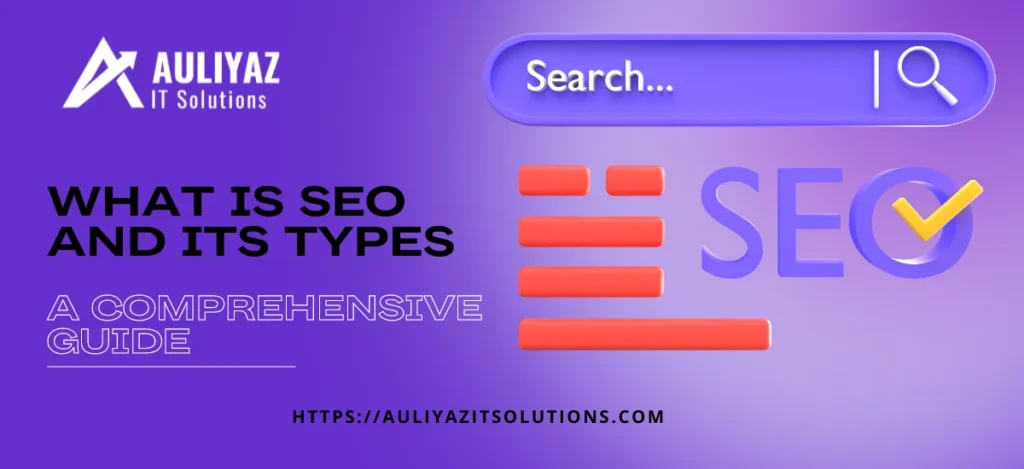In the ever-evolving landscape of the digital realm, SEO (Search Engine Optimization) stands as the cornerstone of online visibility. We delve into the intricacies of SEO, exploring its various types, and unlocking the potential to soar high in Google’s search rankings.
What Is SEO?
SEO encompasses a multitude of strategies and techniques designed to enhance the visibility of a website and ranking on search engine results pages (SERPs). At its core, SEO revolves around aligning website content, structure, and performance with the criteria set by search engines like Google, Bing, and Yahoo. This involves a meticulous blend of on-page and off-page techniques to ensure a website not only ranks higher but also attracts the right audience.
Types of SEO
1. On-Page SEO
On-page SEO focuses on optimizing individual web pages to improve their search engine rankings and attract organic traffic. Key components of on-page SEO include:
- Keyword Optimization: Strategic placement of relevant keywords throughout the content, meta tags, and headers.
- Quality Content: Publishing high-quality, engaging content that addresses the needs and interests of the target audience.
- Meta Tags and Descriptions: Crafting compelling meta titles and descriptions that accurately represent the page’s content.
- URL Structure: Creating clean, concise URLs that incorporate relevant keywords.
2. Off-Page SEO
Off-page SEO revolves around activities conducted outside the confines of the website to bolster its online authority and credibility. Key aspects of off-page SEO include:
- Link Building: Acquiring backlinks from reputable websites and authoritative sources to enhance the website’s credibility and improve its search engine ranking.
- Social Media Engagement: Leveraging social media platforms to promote content, engage with audiences, and amplify the website’s online presence.
- Online Reputation Management: Monitoring and managing online reviews, mentions, and brand perception to cultivate a positive online reputation.
3. Technical SEO
Technical SEO pertains to the optimization of the website’s technical infrastructure and backend elements to facilitate better crawling and indexing by search engines. Vital technical SEO considerations include:
- Site Speed Optimization: Ensuring swift loading times to enhance user experience and mitigate bounce rates.
- Mobile-Friendliness: Designing responsive websites that deliver seamless experiences across various devices and screen sizes.
- Structured Data Markup: Implementing structured data markup to help search engines understand and interpret the content more effectively.
- Sitemap Creation: Generating XML sitemaps to facilitate the discovery and indexing of website pages by search engine crawlers.
Key Types of SEO: Navigating the Digital
Landscape
SEO isn’t a one-size-fits-all endeavor; it’s a multifaceted strategy that adapts to the nuances of the digital landscape. Let’s explore the key types of SEO that can propel your website to the top.
1. On-Page SEO: Precision in Content Optimization
On-page SEO revolves around optimizing individual pages to enhance their search engine visibility. This involves strategic keyword placement, engaging content, and a seamless user experience.
2. Off-Page SEO: Building Digital Authority Beyond Your Site
Off-page SEO focuses on establishing your website’s credibility and authority across the vast expanse of the internet. Quality backlinks, social signals, and brand mentions are the driving forces.
3. Technical SEO: The Backbone of Website Performance
Technical SEO delves into the nitty-gritty of website structure and performance. It encompasses aspects like site speed, mobile-friendliness, and crawlability, ensuring search engines can navigate and index your site effortlessly.
4. Local SEO: Niche Targeting for Localized Impact
For businesses catering to local audiences, local SEO is a game-changer. Optimizing your online presence for local searches ensures your business appears when users in your vicinity seek relevant products or services.
5. Voice Search SEO: Adapting to the Future of Search
With the rise of voice-activated devices, optimizing for voice search is imperative. Understanding user intent and crafting content that aligns with natural language queries can give you a competitive edge.
The SEO Advantage: Beyond Rankings
While the primary goal of SEO is to secure top positions in search results, its impact transcends mere rankings. An optimized website experiences increased organic traffic, improved user experience, and enhanced brand credibility.
Boosting Organic Traffic: The SEO Payoff
SEO isn’t just about securing the top spot; it’s about driving organic traffic to your website. By aligning your content with user intent and search engine algorithms, you create a digital magnet, pulling in your target audience or can get help from an SEO Company.
Improving User Experience: The Unsung Hero of SEO
User experience is paramount in the digital realm. A well-optimized website not only ranks higher but also ensures visitors stay and engage. Fast-loading pages, intuitive navigation, and mobile responsiveness are non-negotiables.
Building Brand Credibility: The SEO Endgame
Securing a prime position in search results isn’t just a badge of honor; it’s a testament to your brand’s credibility. Users inherently trust websites that appear at the top, and SEO is the vehicle that takes you there.
Conclusion:
In the ever-evolving landscape of online visibility, mastering the art of SEO is non-negotiable. From meticulous on-page optimization to building a robust off-page presence, each facet plays a crucial role in propelling your website to the top of Google’s search rankings.

